- Peperomia Serpens: How Easy It Is To Care For It? - September 24, 2021
- Best Indoor Fiberglass Planters Guide: Our Top Picks - September 6, 2021
- Peperomia Polybotrya: Is It Easy To Keep This Plant Alive? - August 31, 2021
Perhaps what draws people to care for different types of monsteras is that the plants are very beautiful, yet each has its own distinct look. Many monsteras also exhibit heterophylly, which is when the leaves on a younger plant look very differently from the leaves of the same plant when it matures.
Some varieties also have different growing patterns. For instance, many monsteras start their lives on the ground, climb up a tree trunk, and then their roots rot and become gigantic air plants. But for all their differences, monstera of different sizes, shapes, types, forms, and varieties have similar care requirements. So if you’re looking to have a collection of different-looking plants with lovely natural holes, monsteras are perfect for you.
Let’s first take a look at the care requirements that every monstera varieties need to gauge if you can properly take care of them. Then let’s deep dive into some of the most popular monsteras so you can choose the ones that you will fall in love with.
How to Identify Monsteras
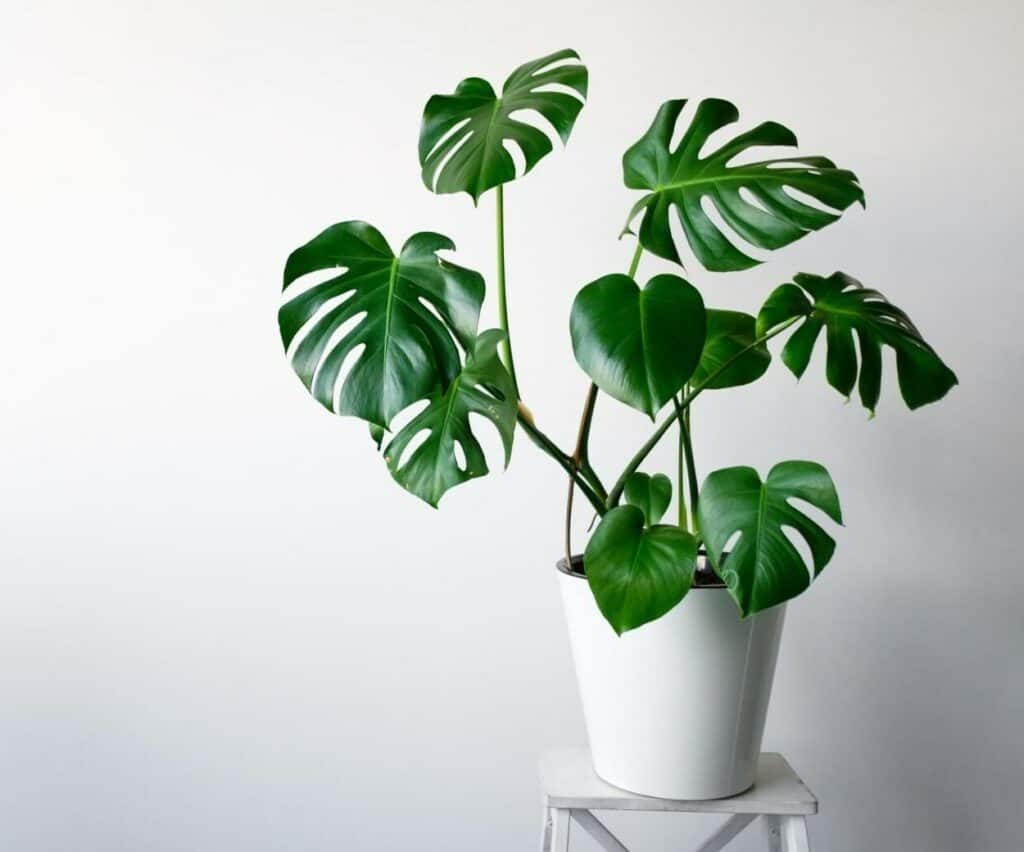
One thing about monsteras is that their looks change as they become mature. It’s not unusual for younger and juvenile monsteras to look radically different when compared to adult plants.
This is because of how these plants grow. A lot of monsteras start off trailing or growing on the ground. As such, their leaves look like those of ordinary plants: complete with no holes.
Then they start climbing trees and their leaves start to develop the holes that give them that distinct look. The holes are there so that strong winds will not be able to blow them off whatever they’re anchoring themselves to. These fenestrations also allow whatever little light to reach the lower leaves, rather than being blocked by the huge leaves.
There are close to four dozen plants included under the monstera genus. Most monsteras have unusual leaves that are huge. Some are considered herbs while others are characterized as evergreen fines. These plants grow up to 66 feet (20 meters) in the wild.
To help them anchor themselves to the trees that they are climbing, monsteras have aerial roots that act as hooks. These aerial roots also go deep into the soil, making the monstera a hemiepiphyte.
Monsteras have mostly dark green and leathery leaves that can be anywhere from 9.8 to 35.4 inches (25 to 90 centimeters) and 5.9 to 29.5 inches (15 to 75 centimeters) wide.
How to Grow a Monstera From Seed
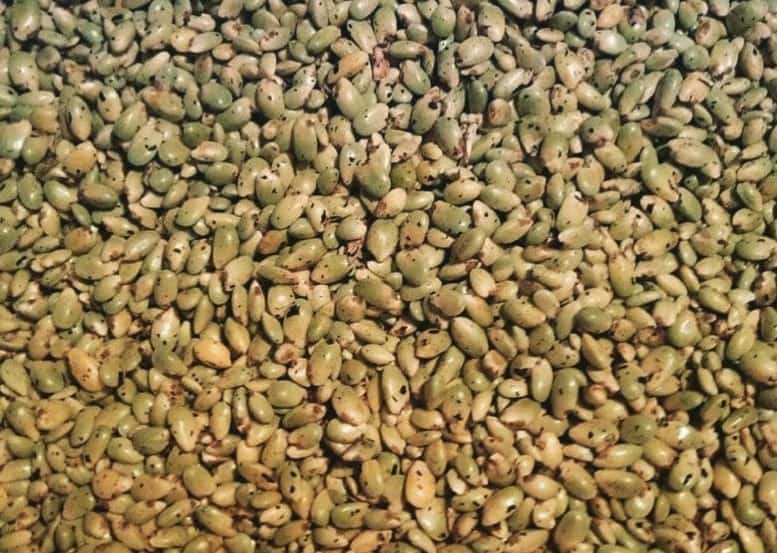
The first thing you should know about monstera seeds is that they don’t have a long shelf life. Once you harvest or buy seeds, you should immediately plant them before they become not viable.
The proper way to plant monstera seeds is to first soak them in water for about 12 hours or wait for the seeds to swell a little. Plant the seeds in soil and be sure to keep the soil moist. Germinating and the first sign of a monstera sapling should take about 10 to 21 days.
How to Plant a Monstera
Monstera might look very different from the houseplants that you have now, but do they need the same care? Fortunately, monsteras are one of the easiest plants to care for, and that little effort is rewarded by their beautiful foliage, huge leaves, and that burst of color it gives your living space.
Monstera Soil and Potting Requirements
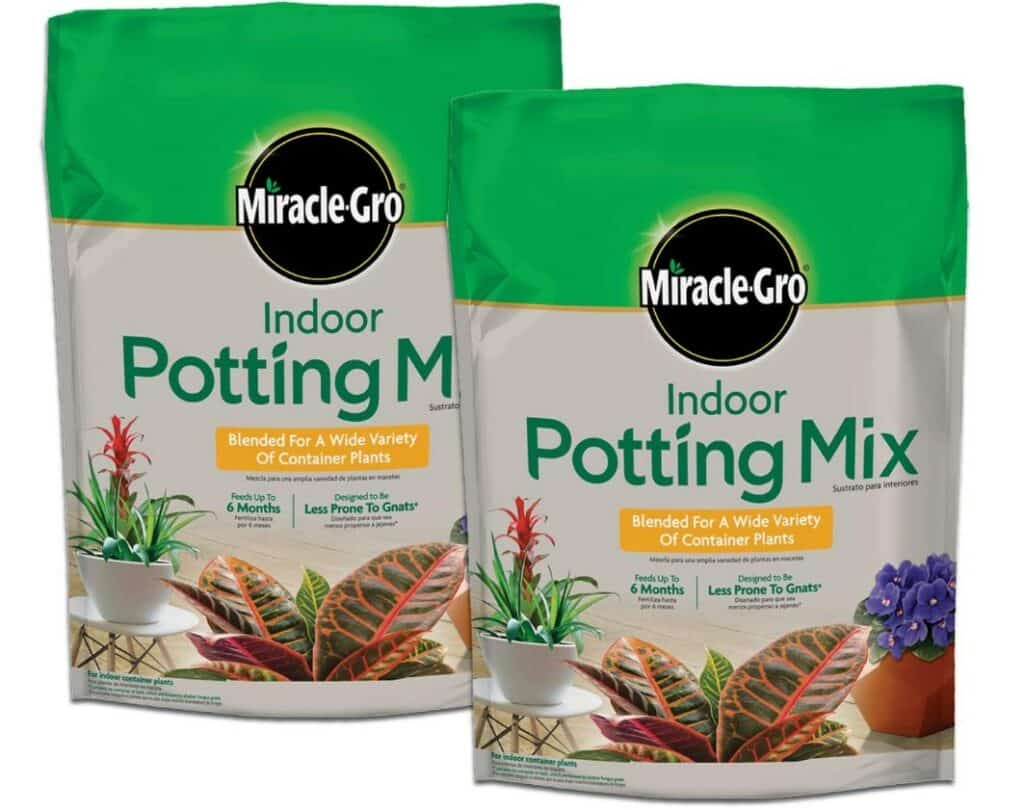
Monstera plants like soil can hold the moisture in, but also drains well. That may sound counterintuitive, but there are soil mixes that can deliver the conditions that a monstera loves. What’s more, these plants thrive in somewhat acidic growing media, with a pH of 5.5 to 6.5. You can create your own by combining peat moss or coco coir, pine bark, and perlite for your monstera.
If you like something storebought, you should find a potting mix that has the same ingredients as above such as the Foxfarm FX14053 Ocean Forest Plant Garden or the Miracle-Gro Indoor Potting Mix. Moreover, you should choose the perfect pot for your monstera. Luckily for you, monsteras are not choosy with their pots. All you need is to get one with a drainage hole.
Monstera Light Requirements

Monsteras prefer indirect bright light, but you can put it in a darker area of your living room with no problem. It can tolerate low light, but it can grow rather slowly.
What you should avoid is putting it under direct sunlight because that can scorch the plant’s leaves. If you’re putting your monstera near a south or southwest-facing window, it’s best to keep it more than 10 feet away so that it doesn’t get hit by direct sunlight.
You can also observe your monstera to see if it’s getting too much direct sunlight and if you can’t put it further away from the window, opt to install blinds or curtains to help filter the sunlight. If you’re putting your monstera near a north-facing window or in a room that doesn’t get too much sunlight, you might want to invest in grow lights. Because monsteras like bright indirect light, grow lights make perfect sense.
We recommend getting grow lights that are bright enough that it mimics the sun. You should be aware that these grow lights are like small suns, and putting them too close to your plants can scorch the leaves as well. You can hang these grow lights from the ceiling. You can also use a lamp, but you have to keep it around 1.6 feet (0.5 meters) away from your plant.
You should also consider the color of the grow lights. It’s much better to admire your monsteras in white light, although there are grow lights that are red or blue.
Further, choose a LED light to save on your electricity bills and further protect your monstera from having its leaves burned. Some products you can try are:
- GE Lighting 93101232 LED Grow Light, PAR38, Balanced Spectrum
- Hydroplanet Grow Light Fixture HPS 150W Complete System with Hydroplanet Lamp
Monstera Watering Requirements
A monstera doesn’t like its roots standing in water. You must water your plant when the top half of the soil is completely dry.
Give it enough water so that it goes through the drainage hole at the bottom. If you use a pot with a saucer, throw away any excess water that accumulates after you irrigate your plant.
Humidity and Temperatures for a Healthy Monstera
Your monstera will probably survive in any place and can be very forgiving when it comes to humidity. But if you have time, you can mist the leaves in the morning to get additional humidity without getting the soil wet.
Further, your monstera should not have any problems at ordinary room temperatures. It thrives between 60 to 80 degrees Fahrenheit (15 to 27 degrees Celsius).
Your plant will not be able to adjust to sudden drops in temperature, so you need to make sure that the area where you put your monstera will not have any cold drafts or even heated air during the winter.
Monsteras particularly hate temperatures colder than 55 degrees Fahrenheit (12.8 degrees Celsius).
Monstera Fertilizers
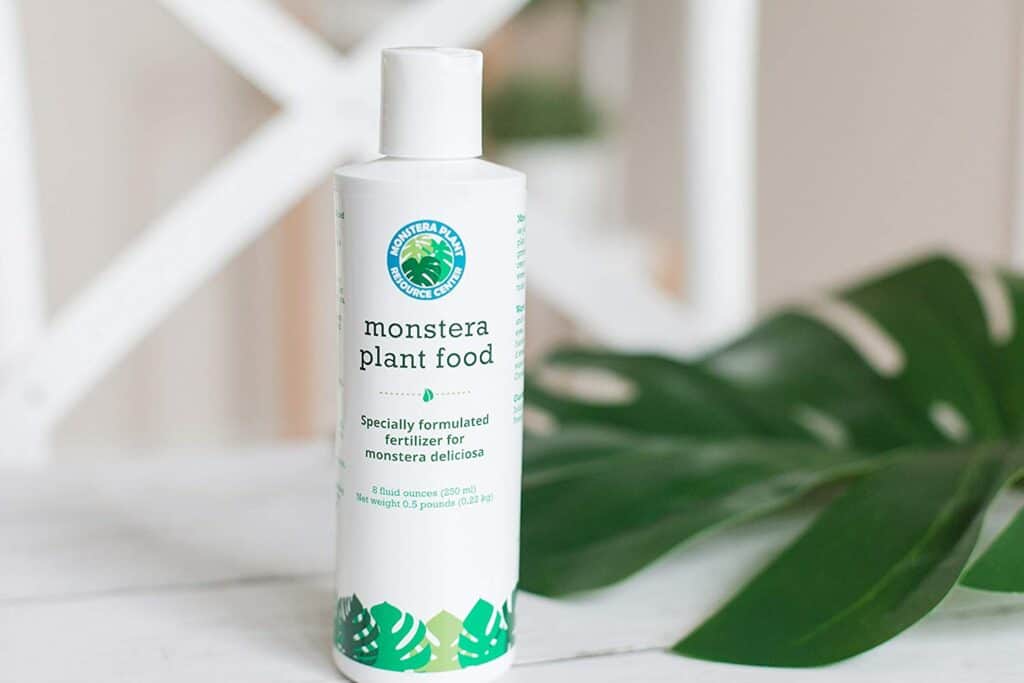
Your monstera will love a good feeding when it’s actively growing during spring or summer. But don’t fertilize your monstera in the winter because that’s the time it stops growing to rest.
Best Monstera Companion Plantings
When it comes to companion plants, you should first check out a pothos plant. These plants have heart-shaped leaves that have yellow and green colorations. Like a monstera, pothos plants can live in low sunlight and indirect light. It can also thrive in soil that’s not so rich in nutrients.
Or you can choose a philodendron plant, which also has the same care requirements as a monstera. Further, you can get a schefflera. Another good idea for companion planting is to have different kinds of monstera in a single pot.
Monstera Diseases and Common Problems
Not giving your monstera the right care might lead to root rot or leaf spots. Leaf spots are small blemished on the monstera’s leaves. These spots gradually become bigger and eventually become on big blotch.
Root rot happens when you overwater your monsteras. This can manifest in the leaves being distorted, yellowing, or wilting. When you check the roots, it’s black and mushy. Aside from these two diseases, your monstera may also get attacked by spider mites, scale insects, and even grasshoppers.
Maintaining Your Monstera
If you want your monstera to grow upwards, you will need to give it a moss pole to climb and provide the offshoots with some support.
You should also check the leaves if it’s getting dusty or dirty. If you notice that the leaves are getting dusty, you can wet a piece of cloth and squeeze out the extra water and wipe the leaves down gently.
The Different Varieties of Monstera That Are Popular Right Now
There are two types of monsteras that you can grow as a houseplant and won’t have problems finding at a Home Depot or your local nurseries. These are the Monstera deliciosa and the Monstera adansonii.
However, there are other varieties of these monster plants that you can grow. The good news is that these plants have more or less the same care requirements.
The Different Kinds of Monstera
Now that you know how to take care of a monstera in general, it’s time to learn the many varieties of monstera that you can own. More importantly, how each one differs from the others. Hopefully, we can introduce some newer kinds of monstera to you.
Or at least, we can help you choose which type is best for you.
Monstera Deliciosa
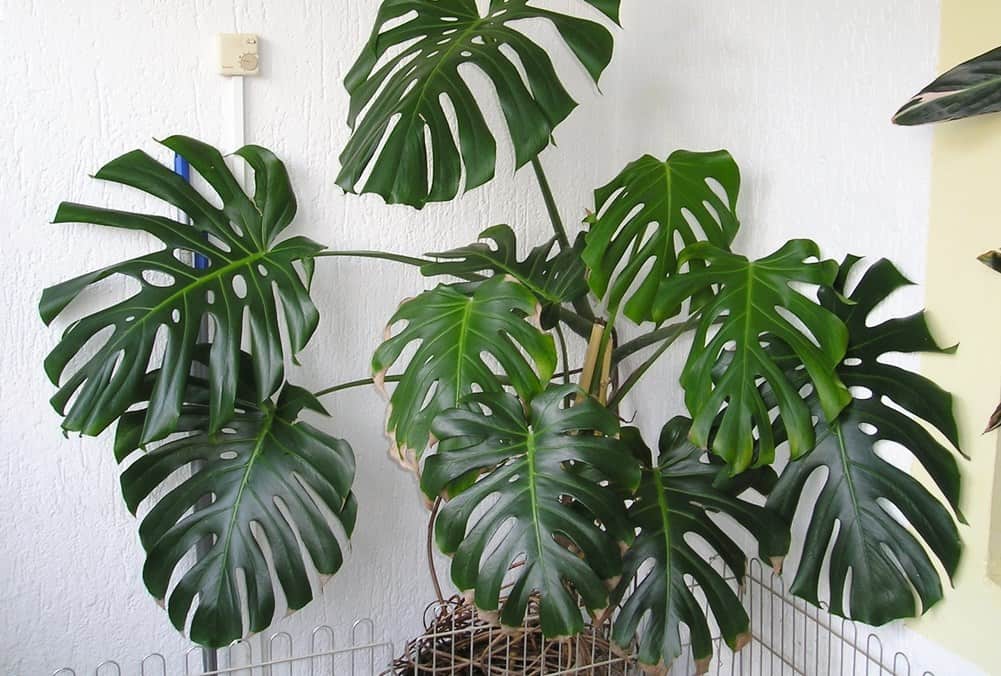
The Monstera deliciosa is probably the most popular of all the monsteras. It is certainly the most common, and you see it being sold just about everywhere.
This variety has large fenestrated leaves that grow on thick stems and aerial roots that are long and cord-like. And in the wild, it can grow up to 70 feet (21.3 meters), but you don’t have to worry because indoors, it only reaches up to eight feet (2.4 meters), and you may prune it to keep it from getting unruly.
The Monstera deliciosa takes its name from the fruit that it produces. The delicious fruit can be toxic when it’s not ripe, but you can treat yourself to a feast of banana-pineapple-tasting fruits when it’s ready to eat.
Monstera Adansonii
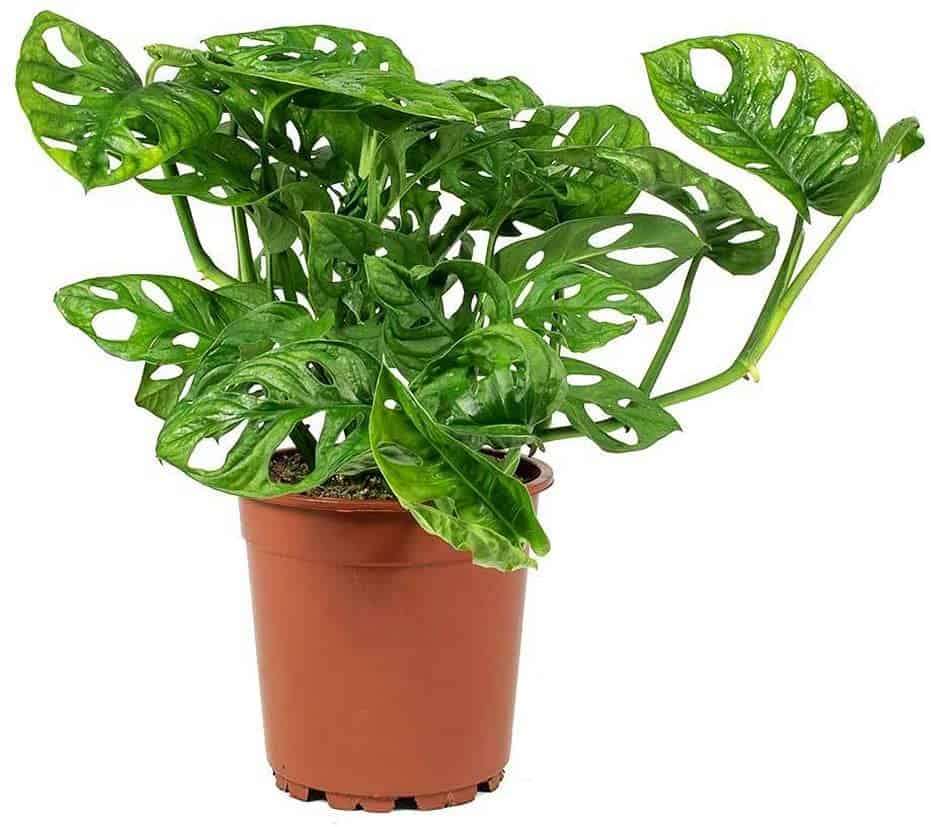
The Monstera adansonii can grow anywhere from 1.3 to 4.9 feet (40 to 150 centimeters). Compared to a Monstera deliciosa, the leaves of this plant is smaller as it can only grow up to 10 to 30 inches (25 to 70 centimeters)+ long and up to 5.9 to 17.7 inches (15 to 45 centimeters) in width. Meanwhile, a deliciosa can go up to 35 inches (90 centimeters) long and 40 inches (100 centimeters) wide.
Another thing that sets the Monstera adansonii apart from the deliciosa is the fenestrations. Adansonii generally has elliptical and self-contained holes in the leaves, with some eight to 16 holes in one leaf. The holes of the deliciosa can be bigger, sometimes measuring 0.3 inches (0.8 centimeters) long. Plus, these holes are not self-contained.
If you want a monstera that you can display from a hanging basket, you will do better with an adansonii as it has a trailing growth habit. The stems and leaves will hang down as they extend.
These plants can also grow along the ground. In general, a Monstera adansonii will grow up to seven to 20 feet (two to six meters). A Monstera adansonii is also more affordable than a Monstera deliciosa.
This variety has slightly different care requirements. For one, it likes to have the soil dry out more, so you will need to water your monstera adansonii a bit less frequently than other monsteras.
Monstera Pinnatipartita
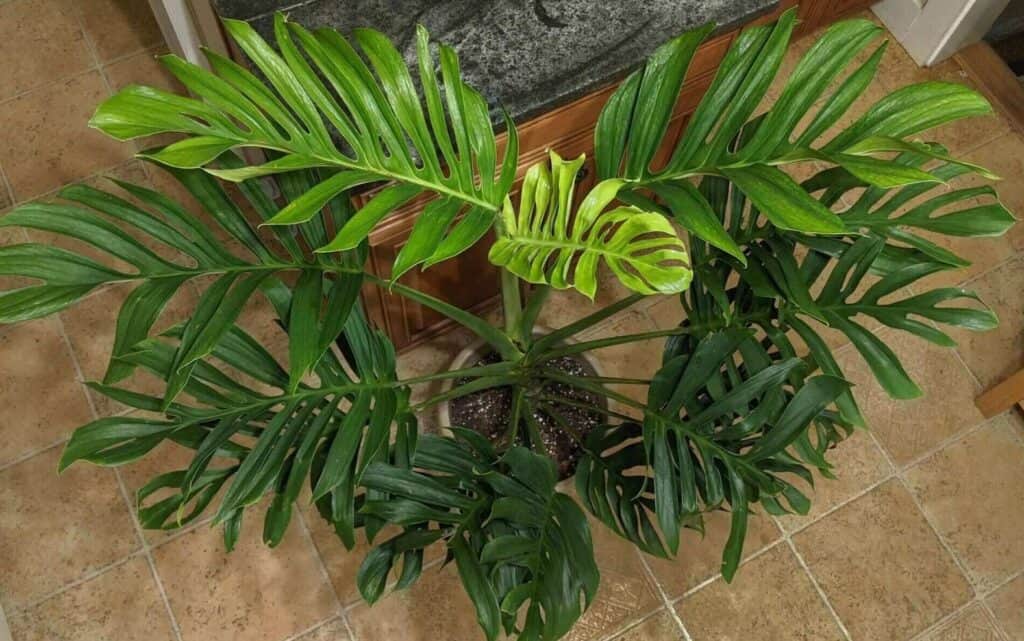
The Monstera pinnatipartita may have a whimsical name, but it’s one of the most interesting varieties for monsteras. The foliage starts out as one whole leaf.
The leaves develop fenestrations as it matures. Instead of just having holes, the Monstera pinnatipartita divides itself from the midrib to the edge.
As such, a young Monstera pinnatipartita will look drastically different from an older one. But even when it’s different in appearance from either a Monstera adansonii or a Monstera deliciosa, the pinnatipartita requires the same care as other varieties.
Monstera Dubia
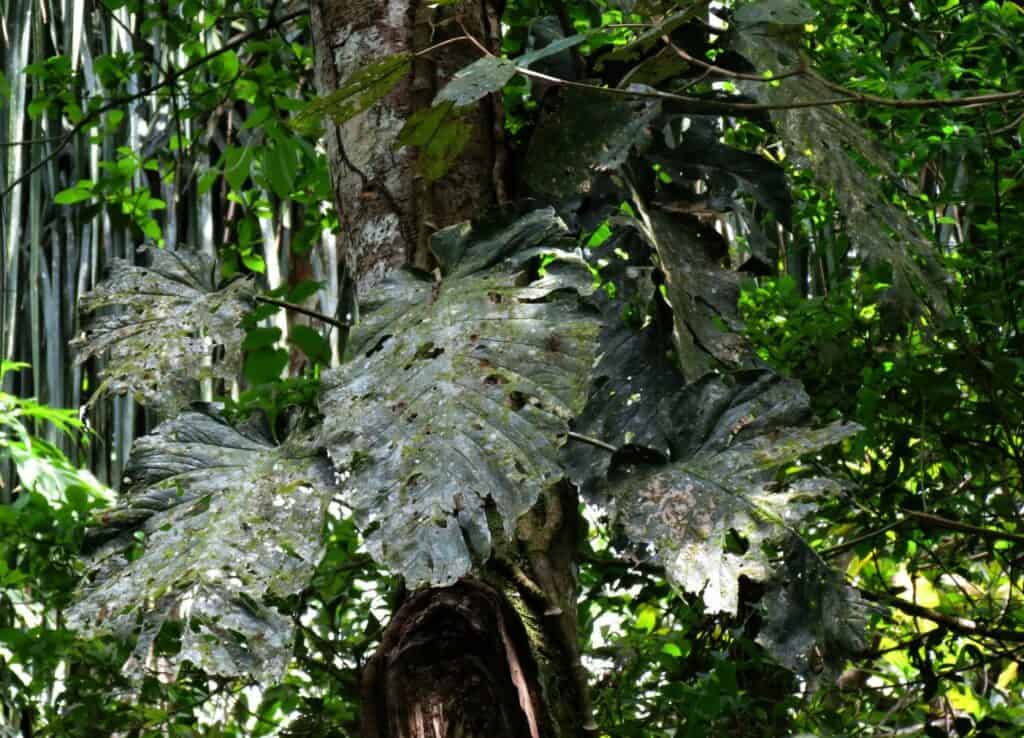
If you want a monstera that doesn’t look like a deliciosa, you can check out the Monstera dubia. Young plants have small heart-shaped leaves with dark green and light green patterns. However, when they grow older, they will start looking like a Monstera deliciosa with big holes in the leaves without the variegation. These larger plants are usually found only in the wild.
A Monstera dubia climbs larger plants and trees, and they tend to stay flat on the surfaces where they grow. These plants like partial sun, moist loamy, and well-draining soil. They usually bloom with pink flowers in the spring or summer.
Thai Constellation
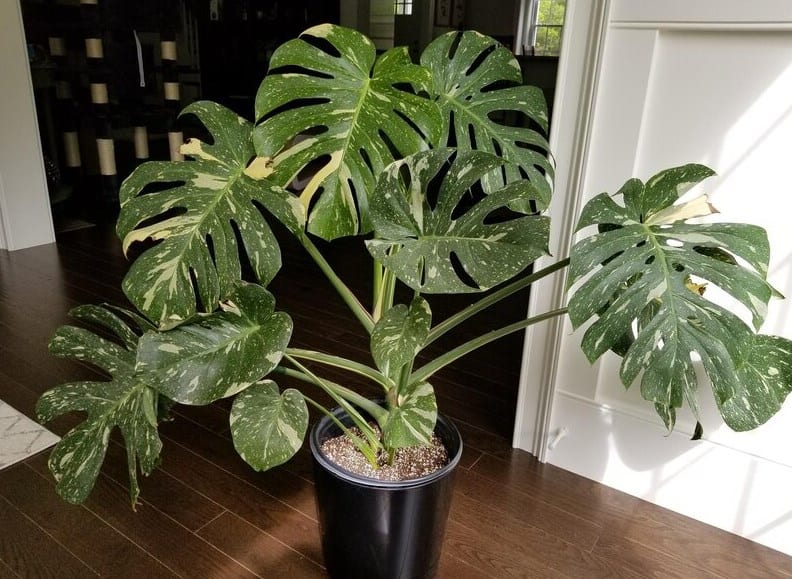
A Thai constellation monstera is a form of variegated Monstera deliciosa. The mutation prevents the leaves from developing chlorophyll. Thus some parts do not have the green pigment and stay white. The plant gets its name from its origins: in a laboratory in Thailand. The marbled patterns with the cream-colored splatter make it looks like a bunch of stars, which look like constellations.
Because it is a variegated form of Monstera deliciosa, the Thai constellation has the same care requirements.
Monstera Obliqua
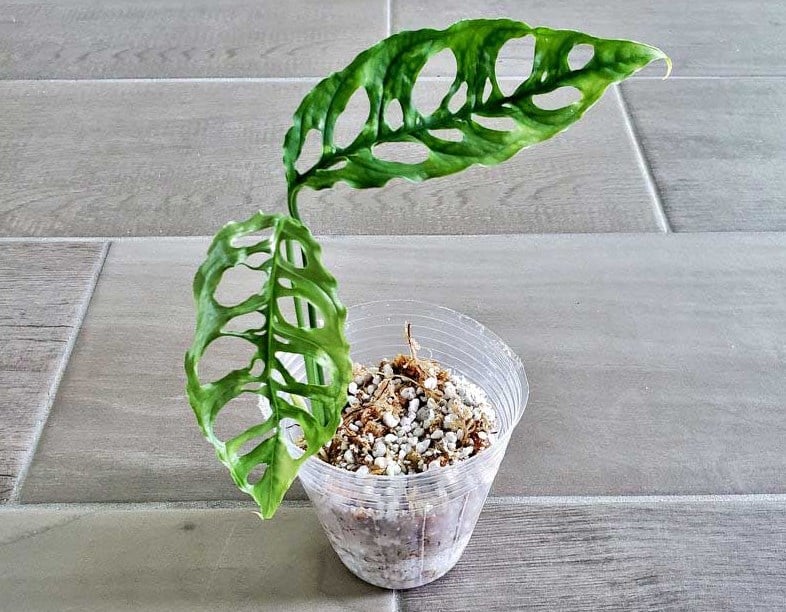
A Monstera obliqua can look very much like an adansonii when it is young. But as it grows older, this plant will begin to have very fenestrated leaves. The holes are so big that the leaves are almost non-existent. In short, you get more holes than green leaves with this plant. They say that up to 90 percent of an obliqua’s leaf is composed of fenestrations.
What’s more, the leaves are very delicate and thin. You might also have a more difficult time finding an obliqua in garden centers, and you mostly have to order one online to get it.
A Monstera obliqua has different humidity and heat requirements than other monsteras. For one, it needs high humidity, so you should aim for 85 percent or more. If you live in the tropics, then you should have no problem. But if you see your monstera struggling, you might want to consider buying a humidifier for your plant.
Another benefit of living in the tropic is that you get warmer temperatures. Your Monstera obliqua likes higher temperatures at around 70 to 85 degrees Fahrenheit (21 to 29 degrees Celsius).
Monstera Standleyana
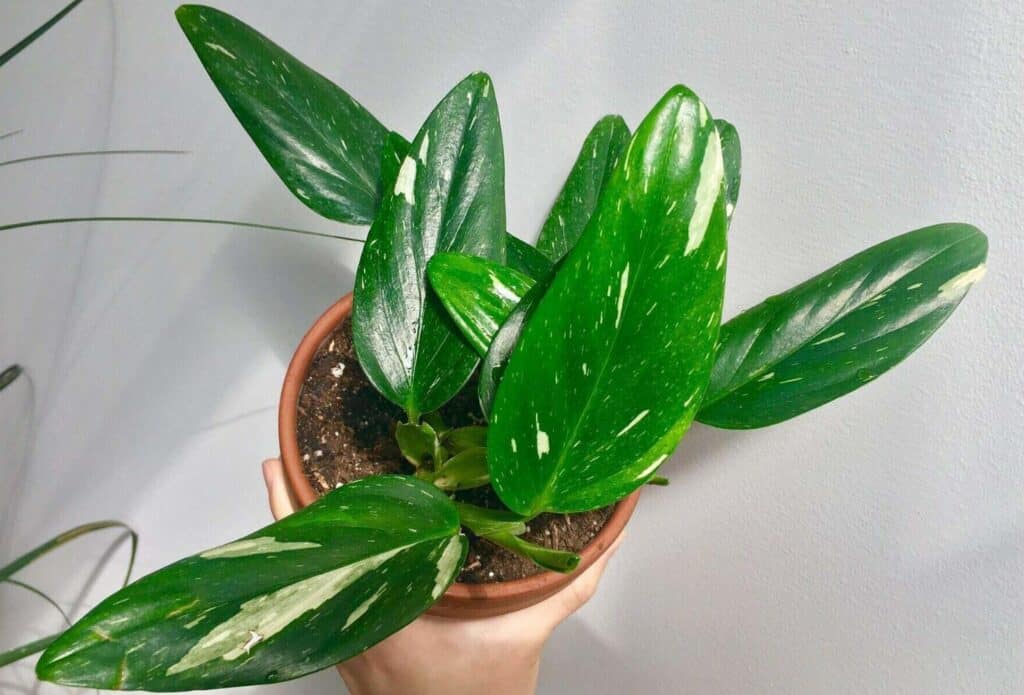
The Monstera standleyana has elongated leaves that have yellow, white, and green coloration. The variegation can be speckles, strips, or blotches.
The plants are often mistaken as Philodendrons, and t can grow three to five feet (0.9 to 1.5 meters) and can get up to three feet (0.9 meters) wide when you put them indoors. But outside, it can grow at least 20 feet (6.1 meters) high.
The leaves can measure anywhere from five to nine inches (12.7 to 22.9 centimeters) long and can be four inches (10.2 centimeters) wide.
Monstera Siltepecana
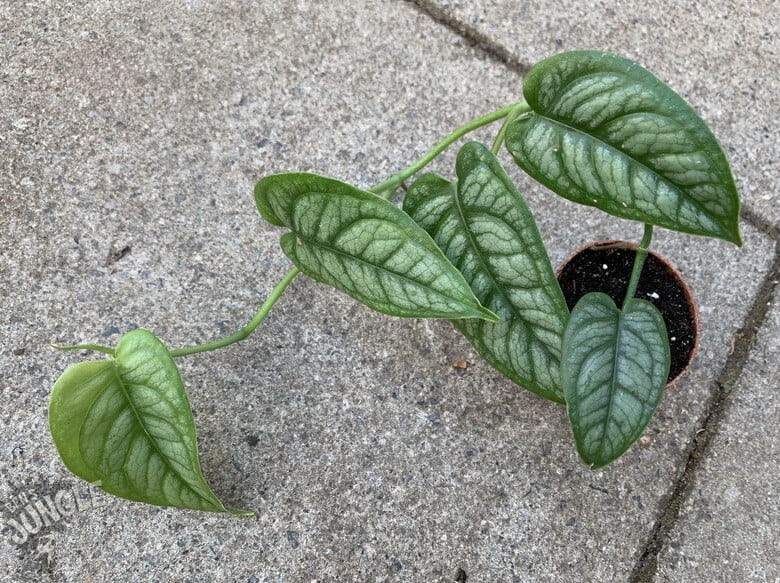
Monstera siltepecana has dark green veins supporting its lighter green leaves. The foliage is adorned with silver patches all over. This monstera climbs when it is properly supported by a moss pole. However, it can also trail if you put it inside a hanging basket.
A younger Monstera siltepecana will have a somewhat bluish leaf along with the silver patches. But as the plant grows more mature, these markings eventually fade. The holes will eventually appear as the plant gets older, and usually, these holes are small and located near the midrib.
Monstera Epipremnoides
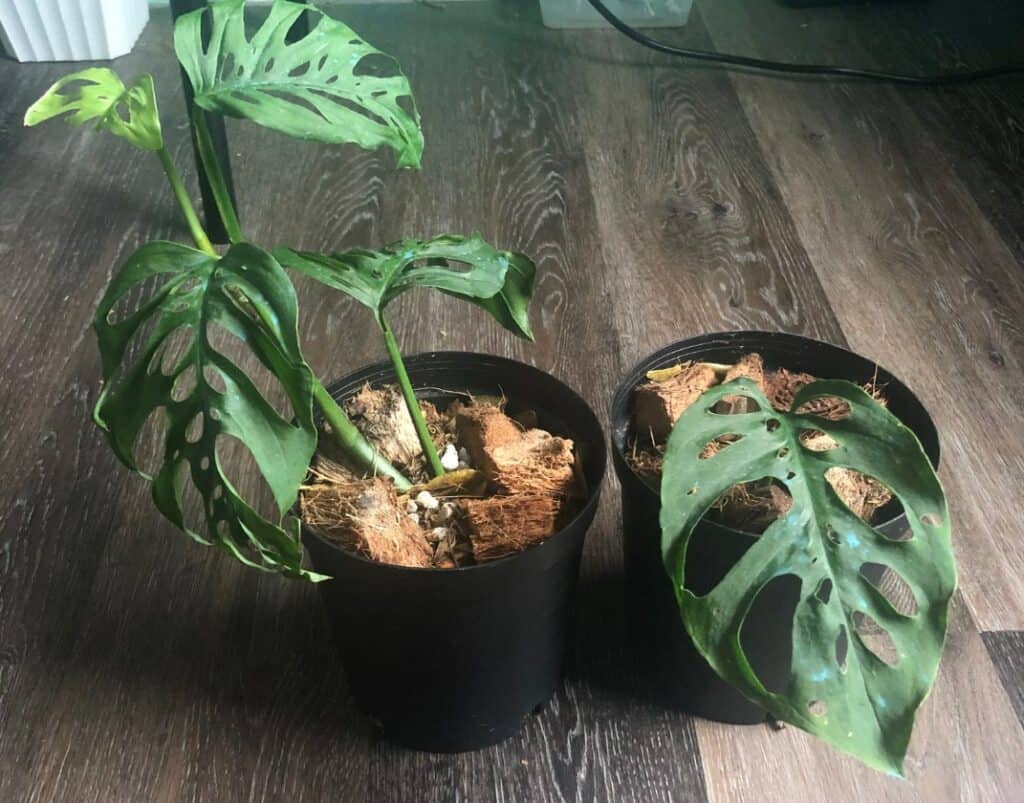
The Monstera epipremnoides is usually mistaken as a type of philodendron when it’s younger or an adansonii when it’s older because of similarities in the foliage and color. But this monstera has bigger leaves and lighter green coloration.
This monstera also has long, sprawling, and thick stems that are connected by aerial roots. Young Monstera epipremnoides have whole leaves with no holes. Eventually, natural holes start appearing from the midribs and then going outwards. As the holes become larger, the fenestrations usually break through the outer edges, giving the epipremnoides a pinnate shape.
If you’re looking for a plant that prefers to be indoors, this is the perfect one for you. And with its heart-shaped leaves that shine, you will fall in love with how pretty it looks.
Monstera Acuminata
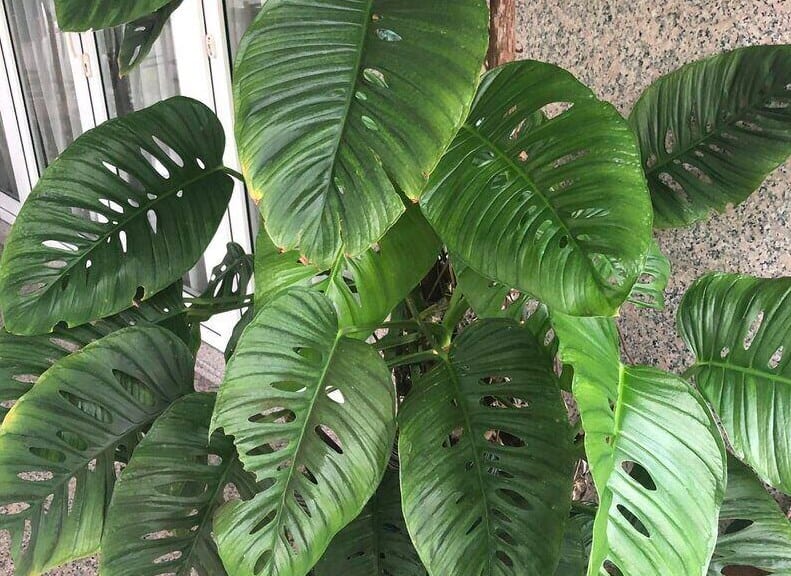
The Monstera acuminata has pointed leaves, which accounts for its name. In the wild, the Monstera acuminata grows out of the ground and starts spreading while keeping itself close to the earth. It continues until it finds a tree trunk, and then it starts to climb. A young plant has small leaves that are quite round, thick, and waxy. But as the plant matures, these leaves will start looking like those of a deliciosa.
A Word on Variegated Monsteras
It’s not a different variety or form; variegation is when your monsteras have leaves with white or cream coloration. Variegated monsteras are probably one of the most sought-after plants for every plant’s person. And it’s easy to see why: a beautiful monstera is made even more eye-catching with the cream or white patterns that it has.
However, because variegation is a mutation, it may be difficult to find a variegated monstera. As such, these plants are often very expensive.
FAQs
Question: How many monstera varieties are there?
Answer: There are 45 species of monsteras that are recognized today. There can be more because not all monsteras in the wild have been properly documented. But still, only a handful of these 45 monsteras are available for sale.
Monsteras are vines that have big and waxy leaves. A lot of them have aerial roots that help them hold on tree trunks as they climb.
These plants are often found in Central to South America, where they can grow in the tropical climate with ease.
Question: Where to buy a monstera?
Answer: Fortunately, these beautiful plants are everywhere. You might be able to find a monstera deliciosa and some other varieties at a local Lowe’s or Home Depot. If not, you can check their online stores.
You can also try Amazon. But for the most part, you might find some excellent monsteras on Etsy. Some sellers even offer some of the rarer varieties, not just Monstera adansonii or deliciosa.
Question: How do you propagate a monstera?
Answer: The good news about monsteras is that you might be able to score one for free. That is, if you have a friend who already owns a monstera, you can just ask for a cutting.
Just make sure that there are two nodes on the cutting and root it in water.
This video will demonstrate how to propagate a Monstera deliciosa, which is similar to how you propagate all monsteras:
Confidently Grow a Monstera at Home!
Having an attention-grabbing monstera in your living room can really change up the décor and provides you with fresher air and something that can help relax your eyes. As you have learned, you just need well-draining soil, the right amount of humidity and water, and indirect sunlight and you’re on your way to having thriving, happy, and healthy monsteras.
Research Citations
- House Racoon: How to propagate a Monstera? It’s Easy
Indoor Plant Addicts: Monstera Deliciosa Diseases and Pests You Should Know - Biology Discussion: Heterophylly and Anisophylly (With Diagram)
The Plant Team: 3 Monstera Companion Plants You Should Check Out - Wikipedia: Monstera
- By Brittany Goldwyn: Thai Constellation Monstera Care & Propagation
Monstera Plant Resource: Monstera Obliqua: Tips for Buying and Caring for This Ultra-Rare Monstera Variety - North Carolina Extension Gardener Plant Toolbox
